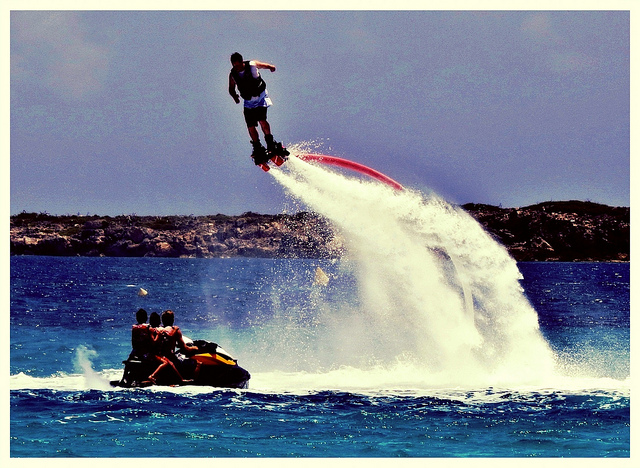Archive for the ‘Seeing Things As They Are’ Category
Rule 1: Don’t start a project until you finish one.
 One of the biggest mistakes I know is to get too little done by trying to do too much.
One of the biggest mistakes I know is to get too little done by trying to do too much.
In high school we got too comfortable with partial credit. Start the problem the right way, make a few little mistakes and don’t actually finish the problem – 50% credit. With product development, and other real life projects, there’s no partial credit. A project that’s 90% done is worth nothing. All the expense with none of the benefit. Don’t launch, don’t sell. No finish, no credit.
But our ill-informed focus on productivity has hobbled us. Because we think running projects in parallel is highly efficient, we start too many projects. This glut does nothing more than slow down all the other projects in the pipeline. It’s like we think queuing theory isn’t real because we don’t understand it. But to be fair to queuing and our stockholders, queuing theory is real.
Queues are nothing more than a collection of wayward travelers waiting in line for a shared resource. Wait in line for fast food, you’re part of a queue. Wait in line for a bank teller (a resource,) you’re queued up. Wait in line to board a plane, you’re waiting in a queue. But the name isn’t important. Line or queue, what matters is how long you wait.
Lines are queues and queues are lines, but the math behind them is funky. From firsthand experience we know longer queues mean longer wait times. And if the cashier isn’t all that busy (in queuing language – the utilization of the resource is low) the wait time isn’t all that bad and it increases linearly with the number of people (or jobs) in the queue. When the shared resource (cashier) isn’t highly utilized (not all that busy), add a few more shoppers per hour and wait times increase proportionately. But, and this is a big but, if the resource busy more than 80% of the time, increasing the number of shoppers increases the wait time astronomically (or exponentially.) When shoppers arrive in front of the cashier just a bit more often, wait times can double or triple or more.
For wait times, the math of queueing theory says one plus one equals two and one plus one plus one equals seven. Wait times increase linearly right up until they explode. And when wait times explode, projects screech to a halt. And because there’s no partial credit, it’s a parking lot of projects without any of the profit. And what’s the worst thing to do when projects aren’t finishing quickly enough? Start more projects. And what do we do when projects aren’t launching quickly enough? Start more projects.
When there’s no partial credit, instead of efficiency it’s better to focus on effectiveness. Instead of counting the number of projects running in parallel (efficiency,) count the number of projects that have finished (effectiveness.) To keep wait times reasonable, fiercely limit the amount of projects in the system. And there’s a simple way to do that. Figure out the sweet spot for your system, say, three projects in parallel, and create three project “tickets.” Give one ticket to the three active projects and when the project finishes, the project ticket gets assigned to the next project so it can start. No project can start without a ticket. No ticket, no project.
This simple ticket system caps the projects, or work in process (WIP,) so shared resources are utilized below 80% and wait times are low. Projects will sprint through their milestones and finish faster than ever.
By starting fewer projects you’ll finish more. Stop starting and start finishing.
Image credit – Fred Moore
Stopping Before Starting
 Whether it’s strategic planning or personal planning, work always outstrips capacity. And whether it’s corporate growth or personal improvement, there’s always a desire to do more. But the more-with-less and it’s-never-good-enough paradigms have overfilled everyone’s plates, and there’s no room for more. There is no more time to double-book and there are no more resources to double-dip. Though the growth-on-all-fronts will not stop, more is not the answer.
Whether it’s strategic planning or personal planning, work always outstrips capacity. And whether it’s corporate growth or personal improvement, there’s always a desire to do more. But the more-with-less and it’s-never-good-enough paradigms have overfilled everyone’s plates, and there’s no room for more. There is no more time to double-book and there are no more resources to double-dip. Though the growth-on-all-fronts will not stop, more is not the answer.
Growth objectives and BHAGs are everywhere and there are more than too many good ideas to try. And with salary increases and incentive compensation tied to performance and the accountability movement liberally slathered over the organization, there’s immense pressure to do more. There’s so much pressure to do more and so little tolerance for a resource-constrained “No, we can’t do that.” the people that do the work no longer no longer respond truthfully to the growth edict. They are tired of fighting for timelines driven by work content and project pipelines based on resources. Instead, they say yes to more, knowing full well that no will come later in the form of slipped timelines, missed specifications and disgruntled teams.
Starting is easy, but starting requires resources. And with all resources over-booked for the next three years, starting must start with stopping. Here’s a rule for our environment of fixed resources: no new projects without stopping an existing one. Finishing is the best form of stopping, but mid-project cancellation is next best. Stopping is much more difficult than starting because stopping breaks commitments, changes compensation and changes who has power and control. But in the age of growth and accountability, stopping before starting is the only way.
Stopping doesn’t come easy, so it’s best to start small. The best place to start stopping is your calendar. Look out three weeks and add up the hours of your standing meetings. Write that number down and divide by two. That’s your stopping target.
For meetings you own, cancel all the status meetings. Instead of the status meeting write short status updates. For your non-status meetings, reduce their duration by half. Write down the hours of meetings you stopped. For meetings you attend, stop attending all status meetings. (If there’s no decision to be made at the meeting, it’s a status meeting.) Read the status updates sent out by the meeting owner. Write down the hours of meetings you stopped attending and add it to the previous number.
If you run meetings 3 hours a week and attend others meetings 5 hours per week, that’s 8 hours of meetings, leaving 32 for work. If you hit your stopping target you free up 4 hours per week. It doesn’t sound meaningful, but it is. It’s actually a 12% increase in work time. [(4÷32) x 100% = 12.5%]
The next step is counter intuitive – for every hour you free up set up an hour of recurring meetings with yourself. (4 hours stopped, 4 hours started.) And because these new meetings with yourself must be used for new work, 12% of your time must be spent doing new work
The stopping mindset doesn’t stop at meetings. Allocate 30 minutes a week in one of your new meetings (you set the agenda for them) to figure how to stop more work. Continue this process until you’ve freed up 20% of your time for new work.
More isn’t the answer. Stopping is.
Image credit – Craig Sefton
Established companies must be startups, and vice versa.
 For established companies, when times are good, it’s not the right time to try something new – the resources are there but the motivation is not; and when times are tough it’s also the wrong time to try something new – the motivation is there but the breathing room is not. There are an infinite number of scenarios, but for the established company it’s never a good time to try something new.
For established companies, when times are good, it’s not the right time to try something new – the resources are there but the motivation is not; and when times are tough it’s also the wrong time to try something new – the motivation is there but the breathing room is not. There are an infinite number of scenarios, but for the established company it’s never a good time to try something new.
For startup companies, when times are good, it’s the right time to try something new – the resources are there and so is the motivation; and when times are tough it’s also the right time to try something new – the motivation is there and breathing room is a sign of weakness. Again, the scenarios are infinite, but for the startup is always a good time to try something new.
But this is not a binary world. To create new markets and new customers, established companies must be a little bit startup, and to scale, startups must ultimately be a little bit established. This ambidextrous company is good on paper, but in the trenches it gets challenging. (Read Ralph Ohr for an expert treatment.) The establishment regime never wants to do anything new and the startup regime always wants to. There’s no middle ground – both factions judge each other through jaded lenses of ROI and learning rate and mutual misunderstanding carries the day. Trouble is, all companies need both – established companies need new markets and startups need to scale. But it’s more complicated than that.
As a company matures the balance of power should move from startup to established. But this tricky because the one thing power doesn’t like to do is move from one camp to another. This is the reason for the “perpetual startup” and this is why it’s difficult to scale. As the established company gets long in the tooth the balance of power should move from the establishment to the startup. But, again, power doesn’t like to change teams, and established companies squelch their fledgling startup work. But it’s more complicated, still.
The competition is ever-improving, the economy is ever-changing and the planet is ever-warming. New technologies come on-line, and new business models test the waters. Some work, some don’t. Huge companies buy startups just to snuff them out and established companies go away. The environment is ever-changing on all fronts. And the impermanence pushes and pulls on the pendulum of power dynamics.
All companies want predictability, but they’ll never have it. All growth models are built on rearward-looking fundamentals and forward-looking conjecture. Companies will always have the comfort of their invalid models, but will never the predictability they so desperately want. Instead of predictability, companies would be better served by a strong sense of how it wants to go about its business and overpowering genetics of adaptability.
For a strong definition of how to go about business, a simple declaration does nicely. “We want to spend 80% of our resources on established-company work and 20% on startup-company work.” (Or 90-10, or 95-5.) And each quarter, the company measures itself against its charter, and small changes are made to keep things on track. Unless, of course, if the environment changes or the business model runs out of gas. And then the company adapts. It changes its approach and it’s projects to achieve its declared 80-20 charter, or, changes the charter altogether.
A strong charter and adaptability don’t seem like good partners, but they are. The charter brings focus and adaptability brings the change necessary to survive in an every-changing environment. It’s not easy, but it’s effective. As long as you have the right leaders.
Image credit – Rick Abraham1
People Are The Best Investment
 Anything that happens happens because of people, and anything that doesn’t happen doesn’t happen because of people. Technology doesn’t create itself, products don’t launch themselves, companies don’t build themselves and trust doesn’t grow on its own. Any kind of work, any kind of service, any kind of organizing – it’s all done by people.
Anything that happens happens because of people, and anything that doesn’t happen doesn’t happen because of people. Technology doesn’t create itself, products don’t launch themselves, companies don’t build themselves and trust doesn’t grow on its own. Any kind of work, any kind of service, any kind of organizing – it’s all done by people.
The productivity/quality movement has been good for factories – parts move in a repeatable flow and they’re processed in repeatable ways by machines that chunk out repeatable output. Design the process, control the inputs and turn the crank. Invest in the best machines and to do the preventative maintenance to keep them in tip-top shape. Just follow the preventive maintenance (PM) schedule and you’ll be fine. But when the productivity/quality movement over-extended into the people domain, things don’t go as well.
People aren’t machines, and their work product is not cookie-cutter parts. And, there’s no standard PM schedule for people. We all know this, but we behave like people are machines – we design their work process, train them on it and measure their output. But machines are iron-based entities that don’t have consciousness and people are carbon-based beings with full consciousness. The best machines do what their told, but the best people tell you what to do. Machines and people are fundamentally different, but how we run them is markedly similar.
Where machines need oil, people need empathy. And for empathy you need vulnerability and for that you need trust. But there’s no standard PM schedule for trust. There’s no flowchart or troubleshooting protocol for helping people. What work do you give them? It depends. When do you touch base and when do you leave them alone? It depends. How much responsibility do you give them? It depends. With machines it’s follow the PM schedule and with people – it depends.
Where machines wear out, people develop and grow. And to grow people you need to see them as they are and meet them where they are. And to do that you’ve got to see yourself as you are. You can’t give people what they need if you add to the drama with your reactivity and you can’t discern their suffering from your projections if you’re not grounded. How much time do you spend each day to learn to dampen your reactivity? How much time do you spend to slow your monkey mind so you can see your projections?
With machines it’s control the inputs and get what you got last time. With people it’s maybe; it depends; don’t worry about how it will go; and why don’t you try? Growing people is much more difficult than keeping machines running smoothly. But, there is nothing more fulfilling than helping people grow into something they couldn’t imagine.
Image credit – Benjamin Balazs
Hep
Hire people that run toward even the toughest problems.
 If you don’t have a problem, there’s no problem. There are no resources without a problem and certainly no focus or momentum. If you don’t know your problem, stop. Take time to define your problem using a single page. Make a sketch or make a block diagram but make it clear. Make it so the problem description stands on its own. After you’ve defined your problem and someone calls it an “opportunity”, walk away because they can’t help you. Taking advantage of opportunities is optional, but solving problems is mission critical. No one worth their salt works on opportunities. Rock stars solve problems.
If you don’t have a problem, there’s no problem. There are no resources without a problem and certainly no focus or momentum. If you don’t know your problem, stop. Take time to define your problem using a single page. Make a sketch or make a block diagram but make it clear. Make it so the problem description stands on its own. After you’ve defined your problem and someone calls it an “opportunity”, walk away because they can’t help you. Taking advantage of opportunities is optional, but solving problems is mission critical. No one worth their salt works on opportunities. Rock stars solve problems.
After you’ve gnawed on a problem for a month and it hasn’t given in, what do you do? When you’ve thrown everything at a problem and it still stands tall, what do you do? When you’ve tried all your tricks and the intractable problem is still blocking an already overdue product launch, what do you do? What you do is find someone who is unafraid trade an intractable problem for a solvable one, someone who will courageously give ground with the hope of opening up new design space, someone who will unabashedly take an anti-conventional (and hopefully controversial) approach. What you do is find a rock star.
Intractable problems are not usually intractable; rather, intractable problems are either poorly-defined problems or are the wrong problem altogether. Either way, it takes someone with courage, usually an outsider, to redefine the problem or see it differently. But because of pride, an outsider can be brought in only after the team has exhausted all other possibilities. Unless there’s a problem with the problem solving team (they can’t solve the problem), there’s no problem. And without a problem, the team won’t accept help from an outsider.
At the rodeo when the cowboy is bucked off the raging bull, the cowboy runs away from the bull but the rodeo clown runs toward the bull to distract it. Like the rodeo clown, the problem solving rock star runs toward raging problems at full tilt. The rock star puts it all on the line as she grabs the problem by the scruff of the neck, wrestles it to the ground and hog ties it. There’s no shyness, just well-practiced technique wrapped in implicit knowledge. With courage and a cloud of dust, it’s no-holds-barred problem solving until the problem gives it up. Nothing is sacred, no assumptions go unchallenged, and no details are too small to ignore. Like rodeo clowns, rock stars know their work looks funny from the outside, but they don’t care. All they care about is solving the problem at hand. Right here, right now.
Before your next intractable problem, take a minute to scan your organization for the special people who have the courage to run toward even the most difficult problems. Don’t be fooled by titles, positional power or how they dress. Look deeply because like rodeo clowns, your magical problem solvers may not look the part on the outside.
Image credit – Ed Schipul
Why not do new work?
 Doing new work isn’t difficult, thinking about is difficult. Stop thinking and start starting; there’s no other way.
Doing new work isn’t difficult, thinking about is difficult. Stop thinking and start starting; there’s no other way.
If you’re a scientist, everything has a half-life. If you’re Buddhist, everything is impermanent. If you’re a CEO, your business model is out of gas. It’s scary to admit everything goes away, but it’s far scarier to deny it.
Just because an idea is threatening doesn’t mean it’s threatening. It probably means it’s one hell of a good idea.
If it’s not different, it can’t be innovation.
Projects take too long because they’re poorly defined. On a single page, define the novel usefulness the project will deliver, make a crude prototype and show it to potential customers. Refine, learn and repeat. Then launch it. (This is the essence of Lean Startup without all the waste.)
If I could choose my competition, I’d choose to compete with no one.
Failure is never the right word. Don’t use it. Ever. (Even failing forward or forward failing should not be used.) No one wants to fail. No one will ever want to fail. Replace of the word “failure” with “learning” and learn quickly.
If you’re not scared, you’re not doing innovation.
Companies offer more-with-less for as long as they can; and when there’s nothing left they offer more-with-more. It would be better to offer less-with-far-less.
For Franklin D. Roosevelt, the only thing to fear was fear itself. For business, the only thing to fear is the cow path of success.
Image credit – JasonParis
How To Learn Quickly
 When the work is new, it all comes down to learning. And with learning it all comes down to three questions:
When the work is new, it all comes down to learning. And with learning it all comes down to three questions:
- What do you want to learn?
- What actions will take to learn what you want to learn?
- How will you decide if you learned what you wanted to learn?
There are many definitions of learning. To me, when your beliefs change, that’s learning. If your hunch moves to a validated idea, that’s learning. If your understanding of a system moves from “I don’t know” to “I know a little bit.”, that’s learning. If you believed your customers buy your product for Feature A and now you know they really buy it because of Feature B, that’s learning.
What do you want to learn? The best place to start is to clearly define what you want to learn. Sounds easy, but it’s not. Some of the leading thinking recommends you define a formal hypothesis. I don’t like that word. It’s scary, intimidating and distracting. It’s just not helpful. Instead, I suggest you define a Learning Objective. To do that, complete this sentence:
I want to learn if the customer ____________________.
It may take several iterations/meetings to agree on a Learning Objective, but that’s time well spent. It’s faster to take the time to define what you want to learn than to quickly learn something that doesn’t matter. And define the Learning Objective as narrowly as possible. The tighter the Learning Objective, the faster you can learn it.
What actions will you take to learn what you want to learn? In other words, for every Learning Objective create a Learning Plan. Use the Who, What, When format. Define Who will do What and When they’ll be done. To increase the learning rate, define the minimum work to fulfill the narrowly-defined Learning Objective. Just as you defined the Learning Objective narrowly, define the Learning Plan narrowly. And to further speed the learning, set constraints like – no one can travel to see customers; no more than five customers can be contacted; and the Learning Plan must be completed in two days. You’re not looking for large sample sizes and statistical significance; you’re looking to use your best judgement supported by the minimum learning to create reasonable certainty.
How will you decide if you learned what you wanted to learn? Learning requires decisions, decisions require judgement and judgement requires supporting information. As part of the Learning Plan, define the Learning Information you’ll collect/capture/record to support your decisions. Audio recordings are good and video is better. For fast learning, you can record a phone call with a customer or ask them to share their webcam (and record the feed) as you talk with them. Or you can ask them to shoot some video with their smart phone to provide the information needed to achieve you Learning Objective.
To analyze the data, it’s best to review the audio/video as a group and talk about what you see. You should watch for body language as well as listen to the words. Don’t expect complete agreement among your team and expect to create follow-on Learning Objectives and Learning Plans to answer the open questions. Repeat the process until there’s enough agreement to move forward, but don’t wait for 100% consensus.
When you present your learning to company leadership, show the raw video data that supports your learning. Practically, you’ll connect company leaders to customers and let the customers dispel long-held biases and challenge old thinking.
There’s nothing more powerful than a customer telling your company leaders how things really are.
Image credit – Thomas Hawk
How To Create Eye-Watering Ideas
 With creativity, the leading thinking says the most important thing is to create many of ideas. When asked to generate many of ideas, the thinking goes, the team lets go of their inhibitions and good ideas slip through their mental filters. I’ve found that thinking misleading. I’ve found that creating many ideas results in many ideas, but that’s it. Before the session to create new ideas, you already had a pile of ideas you weren’t working on, and after the session is bigger, but not better.
With creativity, the leading thinking says the most important thing is to create many of ideas. When asked to generate many of ideas, the thinking goes, the team lets go of their inhibitions and good ideas slip through their mental filters. I’ve found that thinking misleading. I’ve found that creating many ideas results in many ideas, but that’s it. Before the session to create new ideas, you already had a pile of ideas you weren’t working on, and after the session is bigger, but not better.
What’s needed is several outlandish ideas that make your hair stand on end. The ideas should be so different that they cause you to chuckle to mask your discomfort. These ideas should be borderline unbelievable and just south of impossible. The ideas should have the possibility to change the game and tip your industry on its head.
The “many ideas” thinking has the right intent – to loosen the team’s thinking so they generate good ideas, but the approach is insufficient. To force the team to generated outlandish ideas they must be turned inside-out and put on the rack. Heretical ideas don’t come easily and drastic measures are needed. The team must be systematically stripped of the emotional constraints of their success using the Innovation Burst Event (IBE) method.
To prepare for the IBE, a reward-looking analysis is done to identify traditional lines of customer goodness (for example, miles per gallon for automobiles) and define how that goodness has changed over time (position it on the S-curve.) If the improvement has been flat, it’s time for a new line of customer goodness, and if the goodness is still steadily increasing, it’s time to create a new technology that will provide the next level of improvement. With this analysis the disposition of the system is defined and potentially fertile design space is identified. And within this design space, design challenges are created that force the team to exercise the highly fertile design space during the IBE.
Everything about the IBE is designed to strip the team of its old thinking. The IBE is held at an offsite location to change the scenery and eliminate reminders of traditional thinking and good food is served to help the team feel the day is special. But the big medicine is the design challenges. They are crafted to outlaw traditional thinking and push the team toward new thinking. The context is personal (not corporate) and the scale of the challenge is purposefully small to help the team let go of adjacent concerns. And, lastly, the team is given an unreasonably short time (five to ten minutes) to solve the problem and build a thinking prototype (a prototype that stands for an idea, not at functional prototype.)
Everything about the IBE helps the team let go of their emotional constraints and emit eye-watering solutions. The design challenges force them to solve problems in a new design space in a way and does not give them a chance to limit their thinking in any way. The unrealistic time limit is all-powerful.
Four design challenges is about all team can handle in the one-day IBE. With the IBE they come up with magical ideas clustered around four new areas, new areas that have the potential to flip your industry on its head. In one day, a team can define market-changing ideas that obsolete your best products and even your business model. Not bad for one day.
It may be popular wisdom that it’s best to create many new ideas, but it’s not the best way. And it contradicts popular belief that a team can create three or four game-changing ideas in a single day. But the IBEs work as advertised.
Don’t waste time creating a pile of ideas. Spend the time to identify fertile design space and hold a one-day IBE to come up with ideas that will create your future.
Image credit – moonjazz
Diabolically Simple Questions
 Today’s work is complicated with electronic and mechanical subsystems wrapped in cocoons of software; coordination of matrixed teams; shared resources serving multiple projects; providing world class services in seventeen languages on four continents. And the complexity isn’t limited to high level elements. There is a living layer of complexity growing on all branches of the organization right down to the leaf level.
Today’s work is complicated with electronic and mechanical subsystems wrapped in cocoons of software; coordination of matrixed teams; shared resources serving multiple projects; providing world class services in seventeen languages on four continents. And the complexity isn’t limited to high level elements. There is a living layer of complexity growing on all branches of the organization right down to the leaf level.
Complexity is real, and it complicates things. To run projects and survive in the jungle of complexity it’s important to know how to put the right pieces together and provide the right answers. But as a leader it’s more important to slash through the complexity and see things as they are. And for that, it’s more important to know how ask diabolically simple questions (DSQ).
Project timelines are tight and project teams like to start as soon as they can. Too often teams start without clarity on what they’re trying to achieve. At these early stages the teams make record progress in the wrong direction. The leader’s job is to point them in the right direction, and here’s the DSQ to set them on their way: What are you trying to achieve?
There will likely be some consternation, arm waiving and hand wringing. After the dust settles, help the team further tighten down the project with this follow-on DSQ: How will you know you achieved it?
For previous two questions there are variants that works equally well for work that closer to the fuzzy front end: What are you trying to learn? and How will you know you learned it?
There is no such thing as a clean-sheet project and even the most revolutionary work builds on the existing system. Though the existing business model, service or product has been around for a long time, the project team doesn’t really know how it works. They know they should know but they’re afraid to admit it. Let them off the hook with this beauty: How does it work today?
After the existing system is defined with a simple block diagram (which could take a couple weeks) it’s time to help the project team focus their work. The best DSQ for the job: How is it different from the existing system? If the list is too long there’s too much newness and if it’s too short there’s not enough novelty. If they don’t know what’s different, ask them to come back when they know.
After the “what’s different” line of questioning, the team must be able to dive deeper. For that it’s time one of the most powerful DSQs in the known universe: What problem are you trying to solve? Expect frustration and complicated answers. Ask them to take some time and for each problem describe it on a single page using less than ten words. Suggest a block diagram format and ask them to define where and when the problem occurs. (Hint: a problem is always between two components/elements of the system.) And the tricky follow-on DSQ: How will you know you solved it? No need to describe the reaction to that one.
Though not an exhaustive list, here are some of my other favorite DSQs:
Who will buy it, how much will they pay, and how do you know?
Have we done this before?
Have you shown it to a real customer?
How much will it cost and how do you know?
Whose help do we need?
If the prototype works, will we actually do anything with it?
Diabolically simple questions have the power to heal the project teams and get them back on track. And over time, DSQs help the project teams adopt a healthy lifestyle. In that way, DSQs are like medicine – they taste bad but soon enough you feel better.
Image credit – Daniela Hartmann
How To Allocate Resources
 How a company allocates its resources defines its strategy. But it’s tricky business to allocate resources in a way that makes the most of the existing products, services and business models yet accomplishes what’s needed to create the future.
How a company allocates its resources defines its strategy. But it’s tricky business to allocate resources in a way that makes the most of the existing products, services and business models yet accomplishes what’s needed to create the future.
To strike the right balance, and before any decisions on specific projects, allocate the desired spending into three buckets – short, medium and long. Or, if you prefer, Horizon 1, 2 and 3. Use the business objectives to set the weighting. Then, sit next to the CFO for a couple days and allocate last year’s actual spending to the three buckets and compare the actuals with how resources will be allocated going forward. Define the number of people who will work on short, medium and long and how many will move from one bucket to another.
To get the balance right, short term projects are judged relative to short term projects, medium term projects are judged relative to medium term projects and the long term ones are judged against their long term peers. Long term projects cannot be staffed at the expense of short term projects and medium term projects cannot take resources from long term projects. To get the balance right, those are the rules.
To choose the best projects within each bucket, clarity and constraints are more important than ROI. Here are some questions to improve clarity and define the constraints.
How will the customer benefit? It’s best to show the customer using the product or service or experiencing the new business model. Use a hand sketch and few, if any, words. Use one page.
How is it different? In the hand sketch above, draw the novel (different) elements in red.
Who is the new customer? Define where they live, the language they speak and how they get the job done today.
Are there regional constraints? Infrastructure gaps, such as electricity, water, transportation are deal breakers. Language gaps can be big problems, so can regulatory, legal and cultural constraints. If a regional constraint cannot be overcome, do something else.
How will your company make money? Use this formula: (price – cost) x volume. But, be clear about the size of the market today and the size it could be in five years.
How will you make, sell and service it? Include in the cost of the project the cost to overcome organizational capacity/capability constraints. If cost (or time) to close the gaps is prohibitive, do something else.
How will the business model change? If it won’t, strongly consider a different project.
If the investigations show the project is worthwhile, how would you staff the project and when? This is an important one. If the project would be a winner, but there is no one to work on it, do something else. Or, consider stopping a bad project to start the good one.
There’s usually a general tendency to move medium term resources to short term projects and skimp on long term projects. Be respectful of the newly-minted resource balance defined at the start and don’t choose a project from one bucket over a project from another. And don’t get carried away with ROI measured to three significant figures, rather, hold onto the fact that an insurmountable constraint reduces ROI to zero.
And staff projects fully. Partially-staffed projects set expectations that good things are happening, but they never come to be.
Image credit – john curley
Channel your inner sea captain.
 When it’s time for new work, the best and smartest get in a small room to figure out what to do. The process is pretty simple: define a new destination, and, to know when they journey is over, define what it looks like to live there. Define the idealized future state and define the work to get there. Turn on the GPS, enter the destination and follow the instructions of the computerized voice.
When it’s time for new work, the best and smartest get in a small room to figure out what to do. The process is pretty simple: define a new destination, and, to know when they journey is over, define what it looks like to live there. Define the idealized future state and define the work to get there. Turn on the GPS, enter the destination and follow the instructions of the computerized voice.
But with new work, the GPS analogy is less than helpful. Because the work is new, there’s no telling exactly where the destination is, or whether it exists at all. No one has sold a product like the one described in the idealized future state. At this stage, the product definition is wrong. So, set your course heading for South America though the destination may turn out to be Europe. No matter, it’s time to make progress, so get in the car and stomp the accelerator.
But with new work there is no map. It’s never been done before. Though unskillful, the first approach is to use the old map for the new territory. That’s like using map data from 1928 in your GPS. The computer voice will tell you to take a right, but that cart path no longer exists. The GPS calls out instructions that don’t match the street signs and highway numbers you see through the windshield. When the GPS disagrees with what you see with your eyeballs, the map is wrong. It’s time to toss the GPS and believe the territory.
With new work, it’s not the destination that’s important, the current location is most important. The old sea captains knew this. Site the stars, mark the time, and set a course heading. Sail for all your worth until the starts return and as soon as possible re-locate the ship, set a new heading and repeat. The course heading depends more on location than destination. If the ship is east of the West Indies, it’s best to sail west, and if the ship is to the north, it’s best to sail south. Same destination, different course heading.
When the work is new, through away the old maps and the GPS and channel your inner sea caption. Position yourself with the stars, site the landmarks with your telescope, feel the wind in your face and use your best judgement to set the course heading. And as soon as you can, repeat.
Image credit – Timo Gufler.
 Mike Shipulski
Mike Shipulski